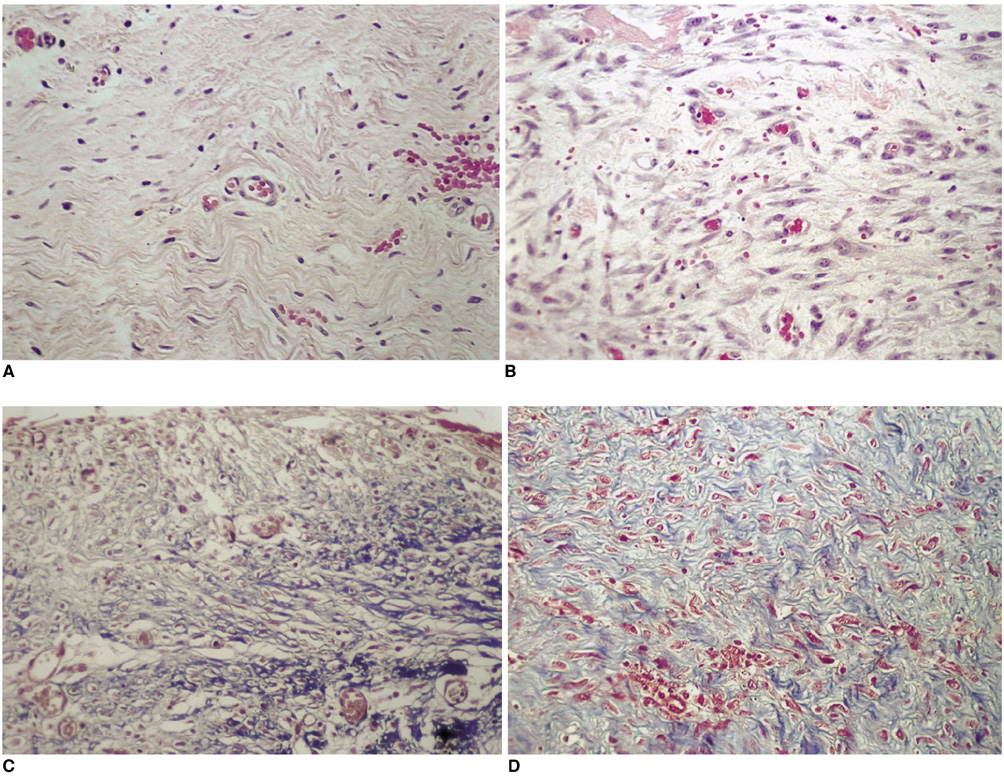Korean J Radiol.
2004 Dec;5(4):266-273. 10.3348/kjr.2004.5.4.266.
Fixation Methods for Implantable Port Chamber: Comparative Study Using Glue, Self-stabilizing Leg and Suture Fixations in Rabbits
- Affiliations
-
- 1Department of Radiology, Chung-Ang University College of Medicine. shimhj@cau.ac.kr
- KMID: 1118834
- DOI: http://doi.org/10.3348/kjr.2004.5.4.266
Abstract
OBJECTIVE
To evaluate the fixation strength and tissue reaction of the glue fixation and self-stabilizing leg fixation methods and to compare the results with those of the conventional tagging suture fixation method. MATER AND METHODS: Twelve healthy rabbits were selected and three different methods of implanting the port chamber were employed on the back of each rabbit. A total of thirty six port chambers were implanted with these three different methods, viz. the glue fixation method using tissue adhesive, the self-stabilizing leg method using a self-expandable stabilizing leg, and the suture fixation method. The fixation strength and the gross and histopathologic changes of each fixation method were evaluated at three days, one week, two weeks and four weeks after port implantation. RESULTS: The glue fixation method showed a good fixation strength, which was similar to that of the tagging suture method (p=0.3486). Five of the six ports (83%) implanted with the glue fixation method which were examined after two weeks showed cracks on the external surface, but this had no adverse effects on their function. A large amount of granulation tissue reaction was found at the bottom of the chamber (p=0.0025). The fixation with the self-stabilizing leg showed relatively lower fixation strength (p=0.0043), but no turning-over of the chamber occurred. The fixation strength improved with time after the first week, and minimal granulation tissue reaction was observed with this method. CONCLUSION: The glue fixation method exhibited equal fixation strength compared to the suture fixation, but showed cracking and a large amount of granulation tissue, whereas the fixation with a self-stabilizing leg showed weaker fixation strength.
Keyword
MeSH Terms
-
Alloys
Animals
Capillaries/cytology/metabolism/pathology
Cell Proliferation
Device Removal
Enbucrilate/therapeutic use
*External Fixators
Fibroblasts/metabolism/pathology
Granulation Tissue/blood supply/metabolism/pathology
*Implants, Experimental
Models, Animal
Rabbits
Sutures/*utilization
Time Factors
Tissue Adhesives/*therapeutic use
Figure
Reference
-
1. Wesenberg F, Anker C, Sommerschild H, Flaatten H. Central venous catheter with subcutaneous injection port (Port-A-Cath): clinical experience with children. Pediatr Hematol Oncol. 1987. 4:137–143.2. Rodgers HC, Liddle K, Nixon SJ, Innes JA, Greening AP. Totally implantable venous access devices in cystic fibrosis: complications and patients' opinions. Eur Respir J. 1998. 12:217–220.3. Gebarski SS, Gebarski KS. Chemotherapy port "Twiddler's syndrome". A need for preinjection radiography. Cancer. 1984. 54:38–39.4. Strecker EP, Ostheim-Dzerowycz W. Newly developed nonsurgical implantable catheter port system to treat patients with advanced peripheral artery disease: first clinical results with 15 patients. Cardiovasc Intervent Radiol. 1995. 18:Suppl 1. S115.5. Martin JK Jr, O'connell MJ, Wieand HS, et al. Intra-arterial floxuridine vs systemic fluorouracil for hepatic metastasis from colorectal cancer. A randomized trial. Arch Surg. 1990. 125:1022–1027.6. Rougier P, Laplanche A, Huguier M, et al. Hepatic arterial infusion of floxuridine in patients with liver metastases from colorectal carcinoma: long-term results of a prospective randomized trial. J Clin Oncol. 1992. 10:1112–1118.7. Misra NC, Jaiswal MS, Singh RV, Das B. Intrahepatic arterial infusion of combination of mitomycin-C and 5-fluorouracil in treatment of primary and metastatic liver carcinoma. Cancer. 1977. 39:1425–1429.8. Shindoh N, Ozaki Y, Kyogoku S, Yamana D, Sumi Y, Katayama H. Stabilization of a percutaneously implanted port catheter system for hepatic artery chemotherapy infusion. Cardiovasc Intervent Radiol. 1999. 22:344–347.9. Yamagami T, Nakamura T, Yamazaki T, Iida S, Kato T, Nishimura T. Catheter-tip fixation of a percutaneously implanted port-catheter system to prevent dislocation. Eur Radiol. 2002. 12:443–449.10. Tanaka T, Arai Y, Inaba Y, et al. Radiologic placement of side-hole catheter with tip fixation for hepatic arterial infusion chemotherapy. J Vasc Interv Radiol. 2003. 14:63–68.11. Wacker FK, Boese-Landgraf J, Wagner A, Albrecht D, Wolf KJ, Fobbe F. Minimally invasive catheter implantation for regional chemotherapy of the liver: a new percutaneous transsubclavian approach. Cardiovasc Intervent Radiol. 1997. 20:128–132.12. Rosenblatt M. Catheter choice: clinical perspective. Workshop handbook. 1998. In : 23rd SCVIR annual meeting; 543–552.13. Fortuny IE, Theologides A, Kennedy BJ. Hepatic arterial infusion for liver metastases from colon cancer: comparison of mitomycin C (NSC-26980) and 5-fluorouracil (NSC-19893). Cancer Chemother Rep. 1975. 59:401–404.14. Campisi C, Assenza M, Zappala A, et al. Surgical technique and biomaterials for totally implanted port catheter systems. J Chemother. 1997. 9:155–156.
- Full Text Links
- Actions
-
Cited
- CITED
-
- Close
- Share
- Similar articles
-
- The Effect of Fibrin Glue(Tisseel(R)) on the Filtration Surgery in Rabbits
- Effect of Distances Between Corneoscleral Limbus and Transscleral Sutures on Vision and Refraction in Eyes with Posterior Chamber Intraocular Lens Implanted by Transscleral Suture Fixation
- Long-term results of implantation of posterior chamber intraocular lens by suture fixation
- AN EXPERIMENTAL STUDY ON PATENCY RATE OF MICROVASCULAR ANASTOMOSIS USING FIBRIN GLUE
- Evaluation of the Necessity of Port Fixation in Central Venous Port Implantation




